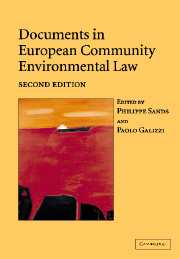Book contents
- Frontmatter
- Contents
- Preface
- PART I General principles of EC environmental law
- PART II European Community institutions and legislation
- PART III The relationship between environmental protection, financial assistance and free trade
- PART IV Procedural techniques of environmental protection
- PART V Protection of air quality
- PART VI Biodiversity and nature conservation
- 28 Council Directive 79/409/EEC of 2 April 1979 on the conservation of wild birds (OJ L 103 25.04.1979 p. 1)
- 29 Council Regulation (EEC) No 348/81 of 20 January 1981 on common rules for imports of whales or other cetacean products (OJ L 039 12.02.1981 p. 1)
- 30 Council Directive 92/43/EEC of 21 May 1992 on the conservation of natural habitats and of wild fauna and flora (OJ L 206 22.07.1992 p. 7)
- 31 Council Regulation (EC) No 338/97 of 9 December 1996 on the protection of species of wild fauna and flora by regulating trade therein (OJ L 061 03.03.1997 p. 1)
- 32 Council Directive 1999/22/EC of 29 March 1999 relating to the keeping of wild animals in zoos (OJ L 094 09.04.1999 p. 24)
- PART VII Waste
- PART VIII Dangerous substances
- PART IX Water quality
32 - Council Directive 1999/22/EC of 29 March 1999 relating to the keeping of wild animals in zoos (OJ L 094 09.04.1999 p. 24)
from PART VI - Biodiversity and nature conservation
Published online by Cambridge University Press: 06 January 2010
- Frontmatter
- Contents
- Preface
- PART I General principles of EC environmental law
- PART II European Community institutions and legislation
- PART III The relationship between environmental protection, financial assistance and free trade
- PART IV Procedural techniques of environmental protection
- PART V Protection of air quality
- PART VI Biodiversity and nature conservation
- 28 Council Directive 79/409/EEC of 2 April 1979 on the conservation of wild birds (OJ L 103 25.04.1979 p. 1)
- 29 Council Regulation (EEC) No 348/81 of 20 January 1981 on common rules for imports of whales or other cetacean products (OJ L 039 12.02.1981 p. 1)
- 30 Council Directive 92/43/EEC of 21 May 1992 on the conservation of natural habitats and of wild fauna and flora (OJ L 206 22.07.1992 p. 7)
- 31 Council Regulation (EC) No 338/97 of 9 December 1996 on the protection of species of wild fauna and flora by regulating trade therein (OJ L 061 03.03.1997 p. 1)
- 32 Council Directive 1999/22/EC of 29 March 1999 relating to the keeping of wild animals in zoos (OJ L 094 09.04.1999 p. 24)
- PART VII Waste
- PART VIII Dangerous substances
- PART IX Water quality
Summary
Editorial note
The aim of Council Directive 1999/22/EC is to protect wild fauna and conserve biodiversity by providing for the adoption of measures by Member States for the licensing and inspection of zoos in the Community, thereby strengthening the role of zoos in the conservation of biodiversity (Article 1). For the purpose of the Directive, ‘zoos’ are defined as all permanent establishments where animals of wild species are kept for exhibition to the public for seven or more days a year, although there are some exceptions (Article 2). The Directive requires zoos to take certain conservation measures, including participating in research, promoting public education and awareness, accommodating their animals under conditions which aim to satisfy the biological and conservation requirements of the individual species, preventing the escape of animals, and keeping up-to-date records of the zoo's collection (Article 3). Member States must adopt measures for licensing and inspection of existing and new zoos (Article 4), although licensing requirements may not apply where a Member State can demonstrate to the satisfaction of the Commission that the objective of this Directive and the requirements applicable to zoos are being met and continuously maintained by means of a system of regulation and registration (Article 5). In the event of a zoo (or part thereof) being closed, the competent authority must ensure that the animals concerned are treated or disposed of under conditions which the Member State deems appropriate and consistent with the purposes and provisions of the Directive (Article 6).
- Type
- Chapter
- Information
- Documents in European Community Environmental Law , pp. 609 - 614Publisher: Cambridge University PressPrint publication year: 2006
- 1
- Cited by



